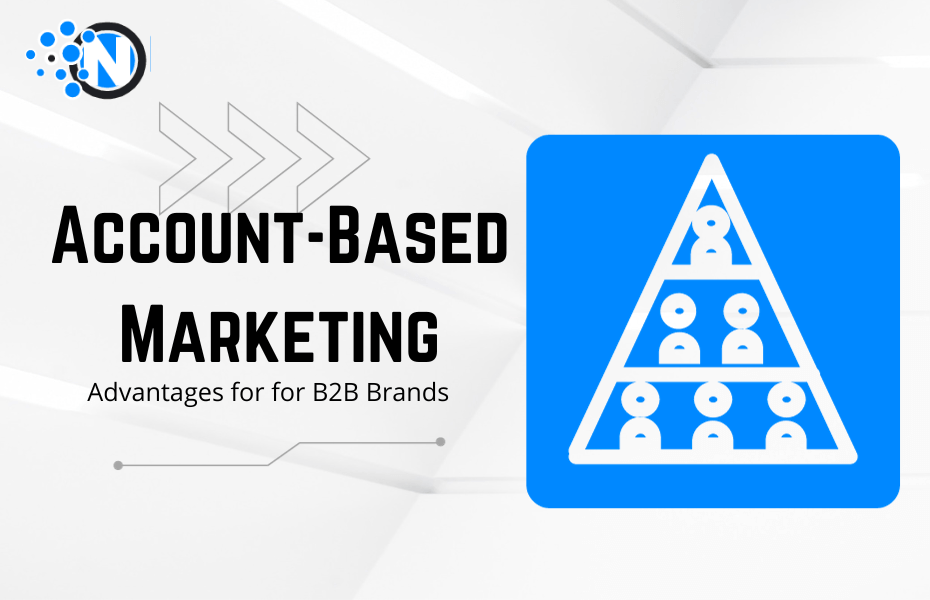Advantages of Account-Based Marketing for B2B Brands

The strategies in B2B marketing are always changing as the industry becomes more diverse in its efforts to reach out to potential customers. Account-Based Marketing (ABM) is a popular strategy; that many people used in the present times. Though it seems to be a buzzword, ABM is a transformative method with numerous benefits for B2B brands.
This article will look into account-based marketing and unveil the ABM advantages for B2B brands associated with this strategy.
What is Account-Based marketing (ABM)?
Account-based marketing is abbreviated as ABM and involves targeting particular companies or accounts as opposed to broad leads attraction. Marketers can treat each account as a unique market and address its specific needs, challenges, and objectives.
ABM is built on the idea of personalization and precision. Instead of creating broad campaigns that appeal to a wide audience, ABM involves creating highly customized marketing initiatives for a select group of accounts. These initiatives can range from personalized content and messaging to tailored advertising campaigns.
Advantages of ABM or Account-Based Marketing for B2B Brands
1- Laser-Focused Targeting
One of the primary advantages of account-based marketing is its precision in targeting. B2B brands can identify and focus their resources on high-potential accounts that are most likely to convert into customers.
Identification of High-Value Accounts: ABM allows B2B brands to pinpoint and prioritize high-value accounts based on criteria such as industry, company size, or revenue potential. With this precision in targeting, marketing efforts are solely toward the most promising prospects, to ensure maximum results.
Reduced Resource Waste: Traditional marketing approaches may cast a wide net, leading to a considerable amount of resources being wasted on leads that have little interest in the product or service. ABM mitigates this issue, reducing resource waste and increasing cost-effectiveness.
Personalized Outreach: With account-based marketing, B2B brands can personalize their outreach to specific accounts, tailoring messages and content to address the unique challenges and goals of each prospect. This personalization greatly improves the chances of engagement and conversion.

2- Improved ROI
By concentrating efforts on a select group of high-value accounts, ABM increases the likelihood of conversion, resulting in a higher Return on Investment (ROI).
Higher Conversion Rates: ABM’s personalized and targeted approach results in higher conversion rates. By focusing on the accounts most likely to convert, brands can maximize their marketing budget and achieve a better return on investment.
Optimized Ad Spend: Account-based marketing ensures that ad spend is allocated to the accounts with the highest potential. This optimization leads to more efficient spending and, ultimately, a more favorable ROI.
Shortened Sales Cycles: Personalizing messaging and targeting higher-quality leads significantly shortens the sales cycle, saving valuable time and resources to convert leads into customers.
3- Enhanced Customer Relationships
ABM’s personalized approach fosters stronger relationships with target accounts. By tailoring marketing messages to address the specific needs and challenges of each account, brands can demonstrate a deep understanding of their customers.
Deep Understanding: ABM allows brands to gain a deep understanding of their target accounts. By researching and tailoring messages to their specific needs, brands demonstrate empathy and a willingness to address the unique challenges faced by their customers.
Trust and Loyalty: Building on the understanding gained through account-based marketing, brands can establish trust and loyalty with their target accounts. This trust often results in long-term, mutually beneficial relationships.
Feedback Loop: ABM encourages ongoing communication and feedback from target accounts. This feedback loop enables brands to continuously improve their offerings and services based on the specific needs and concerns of their customers.
4- Alignment of Sales and Marketing
ABM encourages close collaboration between sales and marketing teams. The alignment of these two functions is critical in B2B, as it ensures that the messaging and outreach to target accounts are consistent and effective.
Unified Goals: ABM fosters alignment by setting unified goals for both sales and marketing teams. These teams work together to engage, nurture, and convert target accounts, ensuring a coordinated approach.
Consistent Messaging: Aligning sales and marketing teams ensures that the messaging used in marketing campaigns is consistent with what the sales team communicates to prospects. This consistency is crucial for a seamless customer experience.
Shared Metrics: ABM often involves the establishment of shared key performance indicators (KPIs) between sales and marketing teams, ensuring that everyone is working towards the same objectives.
5- Shortened Sales Cycles
With ABM, the sales cycle can be significantly shortened. Since the marketing efforts are highly targeted and personalized, potential customers are more likely to move through the sales funnel quickly.
Quick Decision-Making: Since account-based marketing targets high-potential accounts, decision-making within these accounts tends to be faster. The personalized approach and relevant content provided often convince prospects to move through the sales funnel more swiftly.
Fewer Touchpoints: The highly targeted nature of ABM results in fewer touchpoints required to close a deal. This saves time and resources while increasing efficiency.
Streamlined Nurturing: B2B brands can prioritize resources on accounts that are more likely to convert, allowing for more focused and effective lead nurturing.
6- Increased Brand Visibility
ABM allows brands to become highly visible to their target accounts in various ways:
Expertise Showcase: ABM provides an opportunity for brands to position themselves as experts in their industry. By creating content and solutions that directly address the challenges of target accounts, they can establish their authority and credibility.
Thought Leadership: Through content that addresses industry-specific issues, brands can become thought leaders, driving organic growth and attracting inbound inquiries from accounts seeking guidance and solutions.
Word-of-Mouth Marketing: Satisfied target accounts often become advocates for the brand, leading to positive word-of-mouth marketing within their industry.
7- Measurable Results
ABM provides a clear and measurable way to track the success of marketing initiatives.
Account-Specific Metrics: ABM provides the ability to measure results at the account level, allowing brands to see the impact of their efforts on individual accounts.
Continuous Improvement: With measurable results, brands can make data-driven decisions and continually refine their strategies for better performance.
ROI Tracking: ABM facilitates the tracking of return on investment for each targeted account, providing a clear picture of the effectiveness of marketing initiatives.

Challenges and Considerations of ABM
While ABM offers a wealth of advantages for B2B brands, it is essential to be aware of the potential challenges and considerations associated with its implementation:
Resource Intensive
ABM can be resource-intensive, requiring a considerable investment in time, personnel, and technology. Brands must be prepared to commit the necessary resources to see the desired results.
Read Also: What Is The Salesforce Marketing Cloud and How It Can Benefit Your Company?
Data Accuracy
Accurate data is crucial for ABM to be effective. Brands must ensure that their data is up-to-date and accurate to avoid wasted efforts on accounts that are no longer relevant.
Technological Requirements
ABM often relies on marketing technology and automation tools to personalize and scale efforts. Brands must be prepared to invest in these tools and have the expertise to use them effectively.
Alignment Challenges
While ABM promotes alignment between sales and marketing, achieving this alignment can be challenging for some organizations. It requires a cultural shift and a commitment to working together toward common goals.
Content Creation
Creating highly personalized content for numerous target accounts can be a significant challenge. Brands must have the resources and creativity to develop content that resonates with each account.
Longer Sales Cycle for Complex Accounts
In cases where the target accounts are highly complex and have long sales cycles, ABM may require patience and a long-term approach.
Scalability
Scaling ABM efforts can be difficult, particularly for smaller businesses. Brands must carefully plan their scaling strategies to maintain the level of personalization that makes ABM effective.
Conclusion
Account-based marketing is not just a trend; it’s a strategic approach that has become increasingly popular in the world of B2B marketing for its numerous advantages. From laser-focused targeting to improved ROI and enhanced customer relationships, ABM offers a range of benefits that can transform the way B2B brands interact with and convert their target accounts. This strategy is adaptable, data-driven, and capable of addressing the unique needs of a diverse range of target accounts. While it presents challenges and considerations, the potential rewards make Account-Based Marketing a compelling choice for B2B brands looking to thrive in a dynamic and competitive marketplace.




